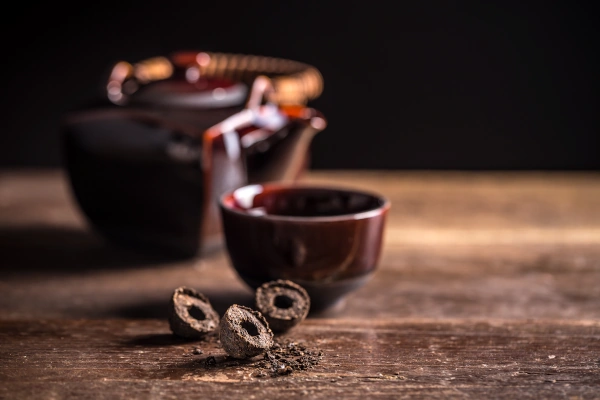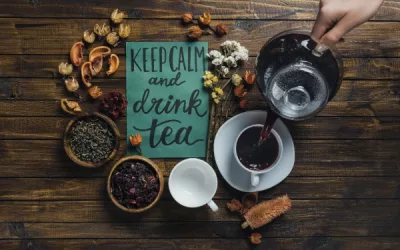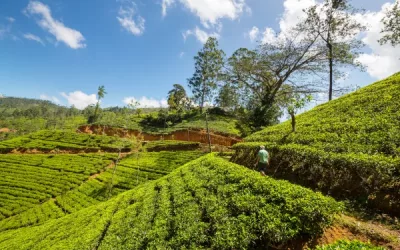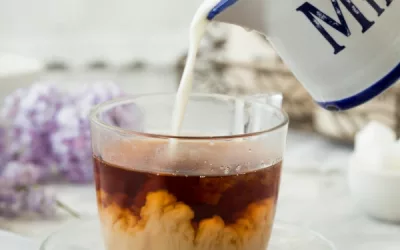Did you know that Pu’erh tea, often referred to as the “elixir of longevity,” has been treasured for centuries in Chinese culture? Originating from Yunnan Province, this unique tea offers not just a rich history but also an array of health benefits and fascinating brewing techniques. As global interest in health-conscious choices grows, understanding Pu’erh tea’s complexities becomes increasingly relevant. This guide will delve into its production, health benefits, brewing methods, and cultural significance, equipping you with everything needed to fully appreciate this remarkable beverage.
Table of Content
- What is Pu’erh tea?
- How is Pu’erh tea made?
- How should Pu’erh tea be brewed for optimal flavour?
- What are the different types of Pu’erh tea available?
- How can consumers ensure they are buying authentic Pu’erh tea?
- What are the best storage practices for Pu’erh tea?
- How does the geographic region influence the flavour of Pu’erh tea?
- What are the cultural significances of Pu’erh tea in China?
- Conclusion
What is Pu’erh tea?
Pu’erh tea (also spelled Pu-erh or Pu’er) is a unique type of fermented tea that comes from the Yunnan province in China. It’s often referred to as the “aged” or “post-fermented” tea, making it quite different from your typical green, black, or oolong teas. This tea has a rich history and an even richer flavor profile, making it a favorite among tea enthusiasts.
Here’s the lowdown:
- Fermentation Process: Unlike other teas, Pu’erh undergoes a fermentation process that can last from several months to several years. This process gives it a deep, earthy flavor and a dark color. Think of it like fine wine – the longer it ferments, the more complex the taste becomes.
- Aging: Pu’erh can be aged for decades, and its value increases over time, much like a bottle of vintage whiskey. The aging process allows the flavors to mellow and develop a smoother taste.
- Two Main Types:
- Sheng (Raw) Pu’erh: This is the traditional, unprocessed version. It’s aged naturally over a long period, sometimes up to 50 years. It has a more intense, grassy flavor and can be quite bitter when young but mellows beautifully with age.
- Shou (Ripe) Pu’erh: This version undergoes a faster fermentation process using controlled heat and moisture to speed up aging. It’s darker and has a smoother, more earthy flavor compared to raw Pu’erh.
- Flavor Profile: Pu’erh is known for its bold, earthy, and sometimes musty flavor. You might get notes of wood, mushroom, or even a hint of smokiness. The taste can be a bit of an acquired one – it’s not your everyday cup of tea, but it’s worth trying!
Pu’erh tea is not just a beverage; it’s a journey. From its ancient roots in Yunnan to your cup, it offers a unique taste experience that evolves with every sip. Whether you’re a seasoned tea drinker or a curious newbie, Pu’erh is definitely worth a try. So, brew a cup, sit back, and let the rich, earthy flavors take you on a journey through time and taste.
What distinguishes Pu’erh tea from other types of tea?
Pu’erh tea stands out from other teas due to several unique properties:
- Fermentation and aging: Unlike green or black tea, Pu’erh undergoes fermentation, which can continue for years.
- Health benefits: It’s believed to aid in digestion, reduce cholesterol, and provide an energy boost.
- Storage and value: Properly stored Pu’erh can increase in value over time, much like fine wine.
- Rich history: Traded along ancient routes, it has a long-standing cultural significance in China.
The fermentation process not only changes the chemical composition of the tea leaves but also leads to the development of complex flavours that other teas don’t possess. This makes Pu’erh a favourite among tea enthusiasts and collectors.
How does the fermentation process affect its flavour?
The fermentation process has a profound impact on the flavour of Pu’erh tea:
- Microbial activity: Different microbes contribute to the breakdown of compounds, creating unique taste profiles.
- Aging: Over time, the tea develops deeper, more complex flavours.
- Raw vs. Ripe: Raw Pu’erh is lighter and more astringent, while ripe Pu’erh is darker and smoother.
- Storage conditions: The environment where the tea is stored can influence its final taste, adding layers of aroma.
The fermentation process is what truly sets Pu’erh apart. The interaction between tea leaves and microbes leads to a transformation that results in a broad spectrum of flavours. From earthy and robust to sweet and mild, the diversity in taste is vast, making every sip an experience.
What are the key historical milestones in the development of Pu’erh tea?
Pu’erh tea has a rich history filled with notable milestones:
- Ancient trade routes: Pu’erh was a valuable commodity along the Tea Horse Road, connecting China to Tibet and beyond.
- Imperial tribute: During certain dynasties, Pu’erh was offered as tribute to the Chinese emperors.
- Modern resurgence: In recent decades, there’s been a renewed interest in Pu’erh tea, leading to increased production and global recognition.
- Cultural preservation: Efforts are ongoing to preserve traditional production methods and protect the cultural heritage associated with Pu’erh.
Understanding the historical context of Pu’erh tea adds to its allure. Each milestone reflects its journey from an ancient trade good to a cherished modern delicacy.
During the Tang Dynasty, Pu’erh tea was transported along the Tea Horse Road, a network of trade routes that facilitated cultural and economic exchanges between China and its neighbours. The tea was often traded for horses, hence the name of the route. This historical trade not only spread the popularity of Pu’erh but also embedded it deeply into the cultural fabric of the regions it reached.
How is Pu’erh tea made?
Pu’erh tea is crafted through a unique process that sets it apart from other types of tea, involving fermentation and aging. The process requires careful handling and often takes years, making it one of the most fascinating and complex teas out there. Let’s dive into the steps involved in making Pu’erh tea, and then I’ll provide a table that summarizes this process.
How Pu’erh Tea is Made
- Harvesting: The process begins with picking fresh leaves from the Camellia sinensis plant, typically from older tea trees in the Yunnan province of China. The best leaves are picked in the spring, which are more tender and flavorful.
- Withering: After harvesting, the leaves are spread out to wither in the sun. This step reduces moisture content, making the leaves more pliable for further processing.
- Pan-Frying (Sha Qing): The withered leaves are then quickly heated in large woks to stop the oxidation process. This step helps retain the natural green color and fresh flavor of the leaves.
- Rolling: The leaves are rolled to break down their cell walls, releasing the natural juices and oils. This step enhances the tea’s aroma and flavor.
- Drying: The rolled leaves are sun-dried to reduce moisture content further. This is an essential step for Raw (Sheng) Pu’erh. For Ripe (Shou) Pu’erh, a controlled fermentation process follows instead.
- Fermentation (Only for Ripe Pu’erh): In the case of Ripe Pu’erh, the dried leaves are piled, moistened, and covered to encourage microbial fermentation. This process, known as “Wo Dui,” can take weeks to months and gives the tea its characteristic dark color and rich, earthy flavor.
- Aging and Pressing: The tea is then aged, which can be done in loose form or compressed into cakes, bricks, or other shapes. Aging can last from a few months to several decades, during which the flavor of the tea continues to develop and mature.
- Packaging: Once the aging process is complete, the tea is packaged carefully to preserve its quality. It can be wrapped in special paper and stored in a cool, dry place.
Table: Steps in Making Pu’erh Tea
The following table outlines the key steps in the production of Pu’erh tea, comparing the processes for Raw (Sheng) and Ripe (Shou) varieties. The table includes details on each step, highlighting the differences and similarities between the two types of Pu’erh tea.
| Step Number | Step Name | Description | Applies to Raw (Sheng) | Applies to Ripe (Shou) | Key Differences |
|---|---|---|---|---|---|
| 1 | Harvesting | Picking fresh tea leaves from tea trees | Yes | Yes | High-quality leaves are preferred for both types |
| 2 | Withering | Leaves are spread out to dry and lose some moisture | Yes | Yes | Sun-withering is common for both |
| 3 | Pan-Frying | Heating leaves in woks to halt oxidation | Yes | Yes | Quick heating to preserve green color and flavor |
| 4 | Rolling | Rolling leaves to release juices and oils | Yes | Yes | Enhances flavor and aroma in both types |
| 5 | Drying | Leaves are dried, usually in the sun | Yes | No | Essential for Raw; Ripe goes to fermentation next |
| 6 | Fermentation | Controlled microbial fermentation process | No | Yes | Unique to Ripe Pu’erh to develop dark, rich flavor |
| 7 | Aging & Pressing | Tea is aged in loose form or pressed into shapes | Yes | Yes | Both types can be aged, but fermentation impacts flavor change |
| 8 | Packaging | Tea is wrapped and stored for sale or further aging | Yes | Yes | Proper storage is crucial for both types |
Structure of the Table
- Columns:
- Step Number: Lists the sequence of the production steps.
- Step Name: Provides the name of each step in the production process.
- Description: Gives a brief explanation of what each step entails.
- Applies to Raw (Sheng): Indicates whether the step is applicable to Raw Pu’erh.
- Applies to Ripe (Shou): Indicates whether the step is applicable to Ripe Pu’erh.
- Key Differences: Highlights the differences or specific details related to each type of Pu’erh tea.
This table outlines the essential steps in making Pu’erh tea, showing how both raw and ripe varieties are crafted, and provides insight into what makes each type unique. Whether you’re into the grassy, fresh notes of Sheng Pu’erh or the earthy, mellow taste of Shou Pu’erh, understanding this process can help you appreciate what goes into each cup.

How should Pu’erh tea be brewed for optimal flavour?
Brewing Pu’erh tea is a bit like dancing: you need grace, rhythm, and a good sense of timing. You can’t just dump boiling water on it and hope for the best – it’s sacrilege, really! Let’s dive into this ritual with some precise and fun instructions to make sure you get the best sip every time.
The key components are water temperature, steeping time, and teapots. But don’t worry, I’ve got you covered.
What is the recommended water temperature for brewing?
Alright, let’s start with the basics. You wouldn’t cook a risotto on high heat, right? Ditto goes for brewing Pu’erh tea. The magical number here falls between 90°C to 100°C.
- Too cold, and you’ll miss out on the complex flavours.
- Too hot, and you’ll end up scalding the leaves, which could make it bitter.
- Think of it as giving the tea a warm bath, not boiling it like a lobster.
So, grab your kettle with a temperature gauge – or if you’re a maverick, let the boiling water sit for a minute before pouring.
How long should Pu’erh tea be steeped for the best taste?
Now onto steeping. This is where patience meets pleasure.
- Your first steep should be quick – about 10 to 20 seconds.
- As you go for subsequent steeps, you can increase the time gradually, say 5 to 10 seconds per round.
This dance allows the leaves to unfurl slowly, releasing their flavours layer by layer. Rushing it would be like fast-forwarding a suspenseful movie – no fun at all!
Can Pu’erh tea be brewed multiple times?
Ah, the beauty of Pu’erh! Unlike your typical one-shot teas, Pu’erh is well-suited for multiple infusions. In fact, connoisseurs often judge its quality by how many times it can be re-brewed without losing its charm. So, yes, Pu’erh tea can – and should be – brewed multiple times.
- Each infusion will reveal different notes. It’s like getting a new gift every time.
- Remember to slightly extend the steeping time for each round after the first infusion.
Additional tips for brewing Pu’erh tea
Here are a few more pointers to elevate your brewing game:
- Brewing equipment: Use a Yixing clay teapot or a Gaiwan. These traditional beauties retain heat well and enhance the flavour profile.
- Water quality: It’s essential. Filtered water is your best bet. Tap water, with its chlorine and whatnot, doesn’t do justice to this noble tea.
- Flavour enhancement techniques: Rinse the leaves once with hot water before your first steep. This ‘awakens’ the tea and washes away any dust.
- Personal preferences: If you like a stronger taste, slightly extend the steeping time or add more leaves. For a milder brew, shorten the steeping duration or use fewer leaves.
- Water temperature: 90°C to 100°C is the sweet spot.
- Initial Steep Time: Start with 10 to 20 seconds.
- Multiple Infusions: Absolutely, go for it!
- Teapots: Yixing clay teapot or Gaiwan are ideal.
- Water Quality: Use filtered water for the best results.
- Pre-rinse: Give the leaves a quick rinse with hot water.
Nailing these will give your Pu’erh tea the optimal flavour that’s rich, smooth, and full-bodied.
One steamy afternoon in the annals of Chinese tea history, Emperor Qianlong of the Qing Dynasty decided to pay a visit to the southern provinces. Being a man of refined tastes and a huge tea aficionado, he was keen to try the famed teas of the region.
During this visit, he was introduced to Pu’erh tea. Legend has it that he was so enamoured by its rich and distinctive taste that he declared it a “Tribute Tea”, a title reserved only for the highest quality teas worthy of the imperial court.
Not just content with this declaration, Qianlong insisted on learning the exact brewing techniques to recreate the perfect cup back in the Forbidden City. Imagine the emperor himself fussing over the water temperature and steeping times – it’s quite the mental image!
What are the different types of Pu’erh tea available?
Pu’erh tea: It’s not just tea, it’s an experience — and a rather complex one at that. Let’s dive into the wild world of Pu’erh and untangle the knots. Pu’erh tea is broadly classified into two types: Sheng (Raw) and Shou (Ripe). But hold your teacup, it gets better. These types can differ vastly not just in production methods, but also in flavour profiles, aging potential, quality indicators, and market availability.
Sheng Pu’erh is the daredevil of teas, fermented naturally over years, while Shou Pu’erh takes a shortcut with an accelerated post-fermentation process. Fancy a tea that can sit on your shelf and become even more valuable over time? That’s Sheng Pu’erh. Need something that’s ready to sip right now? Shou Pu’erh is your go-to.
What are the characteristics of sheng versus shou Pu’erh?
Considering Sheng versus Shou Pu’erh is like choosing between a raw sushi roll and a well-done steak – both delicious but worlds apart.
- Sheng (Raw) Pu’erh:
- Production: Sun-dried and aged naturally over time.
- Flavour: Starts off bitter with astringent notes, maturing into sweeter, more complex flavours over the years.
- Aging Potential: Can age for decades, with flavour evolving over time.
- Quality Indicators: Tight compression, vibrant greenish-brown leaves.
- Market Availability: Generally higher-priced due to the aging process.
- Shou (Ripe) Pu’erh:
- Production: Pile-fermented to speed up the aging process.
- Flavour: Earthy, rich, with immediate readiness; think of the taste of damp forest floor.
- Aging Potential: Less impactful, but does mellow over time.
- Quality Indicators: Dark brown, loosely compressed leaves.
- Market Availability: More affordable and readily available.
Choosing between the two typically boils down to preference: if you love complexity and don’t mind waiting (or, y’know, collecting), Sheng is your cup of tea. If you’re more of a live-in-the-moment person, Shou will promptly reward your impatience.
How does aging affect the quality of Pu’erh tea?
Aging Pu’erh tea is a bit like ageing wine; a well-aged Sheng Pu’erh is the Rolls-Royce of teas. Here’s how aging impacts quality:
- Complexity: Flavours deepen and transform. Sheng Pu’erh moves from harsh and bitter to sweet, floral, and faintly fruity.
- Smoothness: The rough edges wear off, leading to a silky, smooth taste.
- Potency: Just like fine wine, aged Pu’erh becomes more potent in aroma and body.
- Value: Aged varieties fetch higher prices, benefiting collectors over time.
- Balance: Achieves a harmonious balance, combining different flavour compounds into a wholesome experience.
Aging is not just an afterthought; it’s the chef’s kiss. However, age is just a number if stored improperly. Keep your Pu’erh in a cool, ventilated environment away from strong odours to let it mature gracefully.
What should consumers look for when choosing Pu’erh tea?
Alright, Sherlock, here’s your detective guide to picking the ideal Pu’erh tea:
- Purpose: Understand the occasion and purpose. Want it for immediate brewing? Go with Shou. Looking to age it? Opt for Sheng.
- Appearance: High-quality Sheng will have tightly compressed, bright greenish leaves, while good Shou features dark, loose leaves.
- Sourcing: Buy from reputable sources. Dodgy dealers might sell you a ‘vintage’ that’s been aged for all of six months.
- Flavour Preference: Taste test if possible. Some prefer the initial bitterness of Sheng, while others might lean towards the earthy richness of Shou.
- Packaging: Ensure it’s securely packaged to protect against moisture and odours.
- Price: Higher price tags often equate to better aging potential, especially with Sheng.
To navigate the labyrinth of Pu’erh options smartly, these pointers can save you from potential buyer’s remorse.
And speaking of wise choices, did you ever hear about the time a Chinese Emperor supposedly discovered tea because some leaves blew into his boiling water? Legend has it that Emperor Shen Nong, way back in 2737 BC, accidentally stumbled upon the first tea infusion that changed the course of beverage history forever. Talk about luck being a disciplinarian’s hidden ace!
How can consumers ensure they are buying authentic Pu’erh tea?
Navigating the world of Pu’erh tea can be as confusing as trying to remember all your passwords. Unfortunately, the market is teeming with fakes ready to dupe the unsuspecting tea enthusiast. But worry not! Here’s your guide to steering clear of imitation and making sure you’re sipping the real deal.
First off, sourcing from reputable vendors is critical. Think of this like buying a Ferrari; you’d rather hit a certified dealership than Craigslist, right? Trusted vendors have their reputation on the line and strive to offer genuine products.
Next, examine the packaging. Proper packaging is like a tea’s ID card. Look out for clear printing, correct Chinese characters, and the right factory stamps. If it looks like it’s been designed in someone’s basement, that’s a red flag.
Then, dive into the world of certifications. Authentic Pu’erh tea often comes with a certificate, guaranteeing its origin and processing. While it may feel like bureaucracy, it’s ensuring you’re sipping the real deal.
Lastly, recognising quality indicators is a must. Real Pu’erh has certain hallmarks in taste, aroma, and appearance that distinguish it from knock-offs. It’s aged, earthy, and sometimes even holds a bit of a funk. Anything else is like comparing a Rolls-Royce to a roller skate.
What are the signs of genuine Pu’erh tea?
Identifying genuine Pu’erh tea is akin to an art form. Here’s your cheat sheet:
- Aged Look: Authentic Pu’erh tea, especially the aged types, will have darker, more oxidised leaves.
- Earthy Aroma: A true Pu’erh should have a deep, rich, and sometimes earthy or even musty aroma.
- Complex Flavour: The taste should be layered, evolving from earthy to sweet, and sometimes even a touch of bitterness.
- Proper Compression: The tea should be compressed but not overly tight, allowing for proper aging and fermentation.
- Clean Appearance: Look for signs of quality processing. The leaves should be relatively uniform without a lot of stems or dust.
These indicators make it easier to distinguish the authentic from the masqueraders. If something feels off, trust your gut. It’s probably more “meh” than “mmh!”
How can consumers identify a reputable seller?
Choosing a reliable seller is crucial in the quest for real Pu’erh tea. Here’s how to separate the champs from the chumps:
- Reputation: Look for a seller with strong, positive reviews and a solid reputation.
- Specialisation: Retailers who specialise in Chinese teas are more likely to know their stuff.
- Certifications: Sellers offering certified products show dedication to authenticity.
- Transparent Sourcing: Vendors providing details about the tea’s origin and processing are typically more trustworthy.
- Customer Service: Good customer service is a sign of professionalism and can provide extra assurance.
By focusing on these attributes, you’ll be less likely to fall victim to the charlatans and more likely to enjoy genuine Pu’erh.
Are there certifications for authentic Pu’erh tea?
Yes, there are! Navigating certifications may feel like paperwork purgatory, but it’s for your tea-drinking peace of mind:
- China Certification and Inspection Group (CCIC): Provides quality management and analysis reports.
- Menghai Tea Factory Certification: One of the oldest and most respected Pu’erh producers.
- UNESCO’s Intangible Cultural Heritage Inscription: Though not a certification, this recognition adds a layer of authenticity.
Trustworthy vendors should proudly flaunt these certifications like a student with a perfect report card. No certificates? No credibility.
And now for a little something from the history books. Back in the Tang Dynasty (618-907 AD), tea trade thrived along the Tea Horse Road, an ancient caravan route. Pu’erh tea was a treasured commodity, often traded for horses with Tibetan tribes.
This tea was carried across China’s borders on the backs of mules and horses, braving rugged terrain and harsh climates. This arduous journey helped the tea under fermentation and oxidation processes, giving birth to the unique flavour of Pu’erh.
So next time you sip, remember that every sip is a taste of history, borne from centuries of cultural exchange and perseverance. Cheers to that!
What are the best storage practices for Pu’erh tea?
Storing Pu’erh tea isn’t just about stashing it in your cupboard. This isn’t your regular bag of tea leaves. To really make the most of your Pu’erh, you’ll want to nail down ideal storage conditions. We’re talking humidity control, stable temperature, proper light exposure, good airflow, and the right containers. Get these right, and you’ll not only maintain its quality but also enhance its aging potential. So, let’s get into the nitty-gritty of making sure your precious Pu’erh is stored like a champ.
When it comes to keeping that precious Pu’erh in peak condition, it’s all about balance. Let’s be real; nobody wants a mouldy mess or dry and lifeless leaves. So, what’s the magic recipe?
Humidity control: Too dry? Your tea will lose its flavour. Too moist? Say hello to mould. Aim for around 60-70% humidity.
Temperature stability: Don’t let your tea go on a rollercoaster of temperatures. Keep it cool, but not too cold, within a range of 20-25°C is ideal.
Light exposure: Pu’erh and light? Not a match made in heaven. Store it in a dark place. Leave the sunbathing to beach holidays, not tea leaves.
Airflow: Let it breathe! Stale air is a no-go. Proper ventilation ensures the tea ages well.
Storage containers: Use breathable containers like clay jars or paper wrappers. Avoid plastic like it’s the plague; it traps moisture and odours.
Now, let’s dive into the specifics.
What is the ideal humidity level for storing Pu’erh tea?
Getting the humidity right is key to keeping Pu’erh tea happy. You don’t want it too dry or too wet. The sweet spot is around 60-70% humidity.
- Less than 60%: Tea dries out, becomes brittle and loses its aromatic qualities.
- More than 70%: Risk of mould and mildew, turning your tea into a science experiment.
- Use a hygrometer to keep an eye on humidity levels.
- Maintain a consistent humidity level, fluctuations can wreak havoc.
- Consider a humidifier or dehumidifier if you’re serious about your tea game.
The ideal humidity keeps the tea’s flavour intact while allowing it to age gracefully. It’s a bit like wine, just less snooty and more down-to-earth.
How does temperature affect the aging process?
Temperature plays a significant role in how Pu’erh tea ages. Think of it as a slow-cooking process, but unlike your Sunday roast, a steady temperate does wonders here.
- 20-25°C: The goldilocks zone – not too hot, not too cold.
- High temperatures: Speeds up aging but risks cooking the tea, leading to a loss of flavour and nuance.
- Low temperatures: Slows the aging process down to a crawl, and nobody likes waiting forever.
- Stability is key: Avoid places with fluctuating temperatures like kitchens or near windows.
- Natural conditions: Mimic the natural wear and tear process, akin to how cheese is aged in caves.
A stable, moderate temperature lets your Pu’erh tea age like a wise old sage, not like a frenetic high schooler cramming for finals.
What types of containers are best for storage?
Picking the right container for Pu’erh tea is crucial. You wouldn’t store your finest wine in a plastic jug, would you? The same goes for this superb tea.
- Clay jars: Breathable and traditional, allowing air exchange without excessive moisture.
- Basket containers: Allow air to circulate, while keeping light out.
- Paper wrappers: Ideal for short-term storage or keeping individual cakes separate.
- Avoid plastic: Traps moisture and odours, potentially ruining the tea.
- Non-reactive materials: Glass jars with breathable lids can work but keep them dark.
The container acts like a cosy little home for your Pu’erh, ensuring it ages like a fine wine, and not like a forgotten container of take-away.
China’s Yunnan province, the birthplace of Pu’erh tea, has a storied history with this illustrious beverage. Centuries ago, tea merchants travelled the ancient Tea Horse Road, a network of trade routes used to transport tea from China to Tibet and beyond.
They quickly learned that the jostling and exposure during these journeys actually improved the tea’s flavour. This serendipitous discovery helped shape the Pu’erh storage practices we follow today.
So, when you’re marvelling at your perfectly aged brew, give a nod to those old tea merchants who unwittingly pioneered the art of Pu’erh aging. Cheers to history, and happy sipping!
How does the geographic region influence the flavour of Pu’erh tea?
Alright, tea aficionados, buckle up! We’re going on a flavourful journey through the Yunnan province. Yes, that magical land in China where Pu’erh tea thrives and where the flavour of each cup is as diverse as the landscapes.
It’s all about the “terroir,” a fancy-pants term borrowed from wine connoisseurs. We’re talking everything from climate to soil to old-school tea processing techniques that make one Pu’erh tea different from the next.
So, why does a tea from one hill taste like liquid gold while another from the neighbouring slope tastes like, well, not-so-great? Let’s find out!
Terroir here isn’t just a buzzword—it’s the real MVP. The unique geographical characteristics of Yunnan, including the climate, the soil, and the elevation, all work together like some celestial tea brewing orchestra. Let’s break it down:
- Climate: Yunnan isn’t your average region. Its microclimates mean one hillside can have a totally different weather pattern from another just a few miles away.
- Soil Composition: Rich, red, and full of minerals. These soils give Pu’erh its earthiness, something your everyday tea bags can only dream of.
- Elevation: Higher altitudes slow tea leaf growth, making them richer in flavour. Think of it like slow-cooking a stew for days; the longer it simmers, the better it gets.
- Traditional Processing Methods: Holding onto centuries-old traditions, from hand-picking to sun-drying, these methods are the backbone of authentic regional flavours.
- Regional Varieties: Regions like Xishuangbanna, Lincang, and Pu’er each have their own distinctive taste profiles.
So, the next time you take a sip, remember: you’re tasting Yunnan’s entry in a worldly flavour contest.
What role does terroir play in tea flavour?
Terroir, that hard-to-pronounce word (for some), plays a big role in why your Pu’erh tea might taste like a walk through an ancient forest. Talking terroir is like talking about the soul of the tea: it’s the essence, the magic, the je ne sais quoi.
- Microclimate Effects: Rain, sunlight, and temperature; these elements make up the tea’s personality.
- Soil Nutrients: Rich minerals provide that deep, earthy base that’s quintessential for Pu’erh.
- Altitude Specifics: Higher elevations produce leaf flavours that are more nuanced and complex.
- Water Quality: Fresh mountain spring water used in tea processing adds unique characteristics.
- Biodiversity: The surrounding flora and fauna influence the tea leaves through subtle natural processes.
If terroir wasn’t a part of the equation, all Pu’erh teas would taste like they came from a global chain store. No offence to chain stores, but they can’t hold a candle to Yunnan’s naturally nuanced brews.
Are there notable regional varieties of Pu’erh tea?
Oh, you bet there are! Imagine Pu’erh tea as a colourful bunch where every leaf comes with its own twist. Here’s a rundown:
- Xishuangbanna: Tropical vibes with slightly sweet and fruity undertones. Steeped in lush jungles.
- Lincang: Floral notes with a hint of smokiness. Mostly from old wild tea trees.
- Pu’er: Earthy, musty, with a depth that can only be described as a flavour hug from Mother Nature.
- Menghai: Strong, rich and traditionally aged. Perfect for those who prefer a robust kick.
Each region’s tea presents a new chapter in the epic novel of Pu’erh. So, why stick to one type when you can taste them all?
How can consumers explore different regional flavours?
Wanna embark on this flavour adventure? Here’s how you do it:
- Sampler Packs: Grab a variety pack from a reputable seller to get an array of regional flavours.
- Attend Tea Tastings: Check out local tea houses or events. Tasting different varieties side by side is eye-opening.
- Buy Fresh: Age matters, but so does freshness. Opt for fresh leaves to savour the authentic taste profiles.
- Educate Yourself: Get books, read blogs, or find online forums dedicated to Pu’erh tea. Knowledge enhances the experience.
- Visit Yunnan: If you’re a hardcore tea lover, what’s better than going straight to the source?
Exploring different flavours isn’t just about drinking tea; it’s about understanding a rich cultural tapestry. With each cup, you get a slice of Yunnan’s history, geography, and traditional practices.
And speaking of history, did you know that Pu’erh tea was once so valuable it was used as a form of currency in ancient China? Traders would haul these cakes of tea along the famous Tea Horse Road, bartering them for horses and other goods. It was the original ‘bitcoin’ of the days gone by!
The road itself spanned across the borders into Tibet and beyond, making it one of the most significant trade routes in ancient Asia. So next time when you sip on that rich, earthy brew, you’re not just drinking tea; you’re taking part in a thousand-year-old tradition that once moved economies and cultures.
What are the cultural significances of Pu’erh tea in China?
Pu’erh tea isn’t just some random leaf water you chuck into a mug at 7 am. Nope, it’s a brew that oozes cultural heritage, wrapped in layers of history and significance. Originating from Yunnan province, Pu’erh tea has a pedestal of its own in the Chinese tea world.
If we unearth its roots, it’s clear this isn’t your standard cuppa. It’s steeped in centuries-old traditions, making it a key player in ceremonies, social rituals, ancient trade, and even artistic representations.
What is the significance of tea ceremonies in Chinese culture?
Let’s start with the tea ceremonies – the rock star gigs of the tea world. Tea ceremonies in China aren’t just about sipping hot liquid; they’re Zen rituals designed to create tranquillity and connection. Picture a scene: serene setting, delicate pottery, measured movements – it’s like a peaceful ballet but with tea.
- Expression of Art: The way Pu’erh tea is brewed and served reflects a deep appreciation for aesthetics.
- Symbol of Respect: Offering tea in ceremonies symbolises honouring guests or ancestors.
- Spiritual Undertaking: It embodies mindfulness, focusing on the present moment and cherishing the subtleties of life.
- Educational Tool: A method for passing down traditional brewing techniques, ensuring younger generations appreciate their heritage.
- Community Bonding: Strengthens relationships by making each participant an integral part of the ritual.
More than just a beverage, Pu’erh tea in ceremonies is a Zen master, schooling us in mindfulness, tradition, and community bonding.
Moving on to social contexts – Pu’erh tea is like the ultimate social lubricant in Chinese culture. Forget small talk; this tea has set the stage for gatherings, negotiations, and even matchmaking for centuries.
- Gifting Rite: An esteemed gift, representing goodwill, respect, and nobility in personalised packaging.
- Celebratory Staple: It makes appearances at weddings, birthdays, and festivals, akin to popping champagne in the West.
- Business Breaker: A go-to icebreaker in business meetings, laying the foundation for trust and mutual respect.
- Family Gatherings: Drunk during family reunions, it’s emblematic of harmony and collective lineage.
- Health Elixir: Shared for its health perks, symbolising a wish for the well-being and longevity of others.
In essence, serving Pu’erh tea is like offering a slice of good vibes – it fosters connections, seals deals, and celebrates life.
What historical events influenced the popularity of Pu’erh tea?
Now, let’s time-travel and check out the historical hype around Pu’erh tea. This tea isn’t new to the fame game; it’s been rubbed shoulders with emperors and traders for centuries.
- Ancient Trade Routes: The Tea Horse Road – Pu’erh tea was a hot commodity traded for horses, forging a high economic value.
- Imperial Favour: Ming and Qing dynasties took a fancy to it, resulting in an increased popularity and higher demand.
- Cultural Renaissance: The 1980s brought a resurgence of traditional tea culture in China, bringing Pu’erh back into the limelight.
- Medicinal Use: Praised in Traditional Chinese Medicine for its digestive benefits, it became a staple in health-conscious communities.
- Modern Globalisation: Pu’erh tea’s international appeal skyrocketed with collectors, culinary professionals, and tea enthusiasts seeking its unique taste and medicinal attributes.
From the dusty trails of ancient trade to posh modern-day tea houses, Pu’erh tea has earned its stripes through significant historical events, proving its timeless appeal.
Way back during the Tang Dynasty, the Tea Horse Road was bustling with activity. Traders would haul hefty loads of Pu’erh tea across treacherous paths in exchange for warhorses. This tea wasn’t just a drink; it was as precious as gold. And traders knew this. These routes not only enriched cultures but also spread the fame of Pu’erh tea far and wide, embedding it into the very fabric of Chinese society.
So, there you have it. Pu’erh tea is more than your average brew – it’s a culturally-fuelled marvel, bridging the past and present with every sip.
Conclusion
As I reflect on our journey through the rich world of Pu’erh tea, it’s clear that this unique beverage holds far more than just flavour; it encapsulates history, health benefits, and a profound cultural significance. From its origins in the enchanting Yunnan Province to the intricate fermentation processes that distinguish its raw and ripe varieties, Pu’erh tea truly stands apart from other teas. We’ve explored the impact of terroir on its flavour, revealing how regional differences shape each sip.
The health benefits associated with Pu’erh tea are equally compelling, with numerous studies supporting its claims of aiding digestion, weight management, and offering antioxidant properties. However, as with any herbal remedy, it is essential to approach these benefits with an understanding of potential side effects, ensuring a well-rounded view of what this remarkable tea can offer.
When it comes to brewing, we learnt that precision and preference play crucial roles in extracting the best flavours. The versatility of Pu’erh tea allows for multiple infusions, reflecting the depth of its character whether steeped in a traditional teapot or a more modern brewing device.
Ensuring the authenticity of Pu’erh tea is a challenge faced by many enthusiasts. By sourcing from reputable vendors and understanding crucial quality indicators, I can confidently make informed decisions in this meaningful pursuit. Proper storage further enhances my enjoyment of this tea, as I strive to maintain its quality and maximise its aging potential.
Through it all, I’ve appreciated not only the taste but also the cultural richness of Pu’erh tea. Observing its role in traditional tea ceremonies and social gatherings has deepened my understanding of its significance in Chinese culture, reinforcing that drinking Pu’erh is more than an indulgence; it is a connection to a time-honoured tradition.
Ultimately, as we embrace the world of Pu’erh tea, I encourage you to embark on your own exploration—taste the different varieties, participate in the rituals, and share these experiences with others. In doing so, you become part of a larger narrative that spans centuries and continents. Let us remember the words of Chinese philosopher Laozi: “A journey of a thousand miles begins with a single step.” In the case of Pu’erh tea, maybe that single step starts with brewing a cup and allowing it to lead us wherever it may.
Resources
- Chemical constituents and biological properties of Pu-erh tea
- Pu-erh Tea Protects the Nervous System by Inhibiting the Expression of …
- Antioxidant Phenolic Compounds from Pu-erh Tea – PMC
- Impact of Fermentation Degree on The Antioxidant Activity of Pu‐Erh Tea …
- Pu-erh tea: A review of a healthful brew – ScienceDirect
- Recent advances on the beneficial use and health implications of Pu-Erh tea
- Effects of bioactive components of Pu-erh tea on gut … – PubMed
- Chemical profile of a novel ripened Pu-erh tea and its metabolic …







